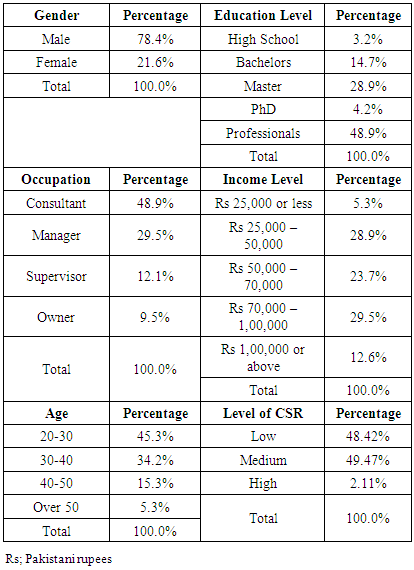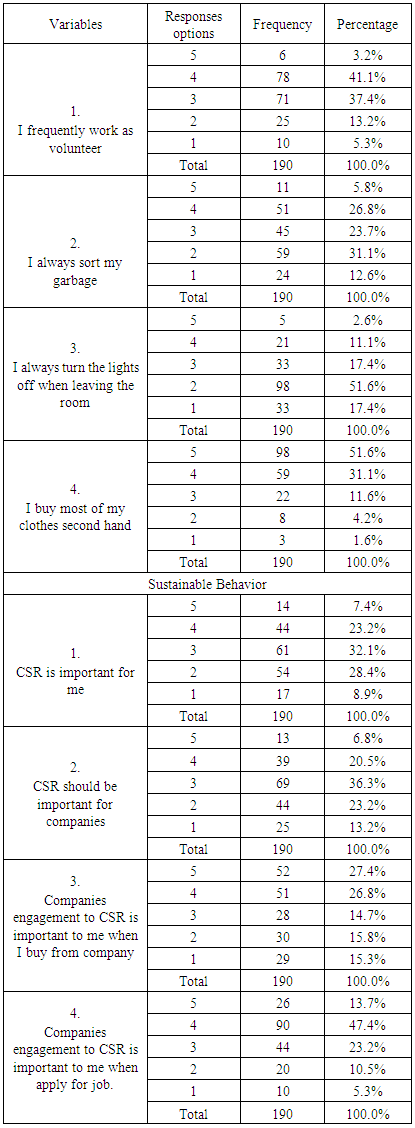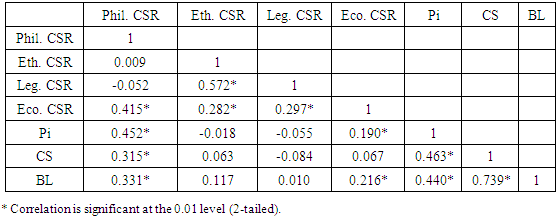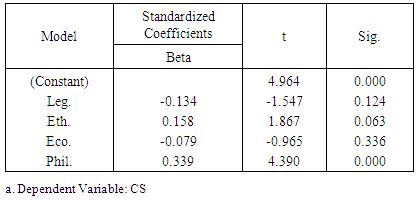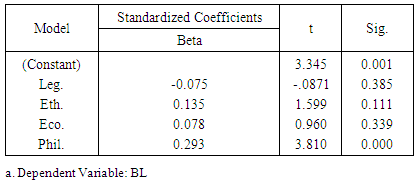-
Paper Information
- Previous Paper
- Paper Submission
-
Journal Information
- About This Journal
- Editorial Board
- Current Issue
- Archive
- Author Guidelines
- Contact Us
Management
p-ISSN: 2162-9374 e-ISSN: 2162-8416
2018; 8(2): 54-63
doi:10.5923/j.mm.20180802.03

Impact of CSR Dimensions on Consumer Satisfaction and Brand Loyalty in the Formation of Purchase Intentions: Study from Pakistan Livestock Industry
Jun Fan1, Subhani Hafiz Inayat Ul Haq1, Ailton Gomes Moeriera1, Mubashar Mumtaz Virk2
1School of Business Administration, Zhejiang Gongshang University, Hangzhou, China
2School of International Business, Zhejiang Sci-Tech University, Hangzhou, China
Correspondence to: Subhani Hafiz Inayat Ul Haq, School of Business Administration, Zhejiang Gongshang University, Hangzhou, China.
| Email: |  |
This work is licensed under the Creative Commons Attribution International License (CC BY).
http://creativecommons.org/licenses/by/4.0/

The manuscript aims to determine the impact of consumer satisfaction and brand loyalty along with corporate social responsibility (CSR) initiatives taken by national or multi-national companies in livestock industry of Pakistan in formation of purchase intention of consumers. Data from 190 respondents were collected through questionnaire survey. Data analysis was performed using statistical package for the social sciences 21.0 (SPSS) software. Hypotheses were tested by regression beta-coefficient and correlation coefficients. The findings of this study showed that philanthropic CSR have positive and significant relationship with consumer satisfaction and brand loyalty. A weak relationship of ethical responsibility and brand loyalty has been observed. This study found negative relationship of two CSR dimensions, legal and economic, with consumer satisfaction and brand loyalty. Moreover, it is concluded that consumer satisfaction has positive relationship with brand loyalty and purchase intention. Results have confirmed the positive impact of brand loyalty on purchase intention. Our study concludes that improvement of philanthropic and ethical CSR can improve consumer satisfaction, which may influence the buying intentions of consumers and motivate them to be loyal to the brand. Thus, companies working in livestock industry should put CSR factors into action in consumer’s perspective which will make organization-consumer bond stronger.
Keywords: Corporate social responsibility, Consumer satisfaction, Brand loyalty, Purchase intention, Livestock industry
Cite this paper: Jun Fan, Subhani Hafiz Inayat Ul Haq, Ailton Gomes Moeriera, Mubashar Mumtaz Virk, Impact of CSR Dimensions on Consumer Satisfaction and Brand Loyalty in the Formation of Purchase Intentions: Study from Pakistan Livestock Industry, Management, Vol. 8 No. 2, 2018, pp. 54-63. doi: 10.5923/j.mm.20180802.03.
Article Outline
1. Introduction
- Corporate social responsibility (CSR) is a hard-edged business decision. Though CSR is not very common in developing countries e.g. Pakistan, but due to global challenges now businesses must go for sustainable community development through its volunteer actions beyond its monetary goals. The security and exchange commission of Pakistan has given voluntary guidelines for CSR, following the mandatory CSR general order 2009 [1]. According to these orders and guidelines public companies should disclose all monetary and descriptive community goals in their director’s report. Although companies are allowed to set their own CSR interests, however, a few companies have formed their CSR strategies of international standards and still a large number of companies are either unaware of CSR or they have only token recognition. It is very important for a company to have a balance in its economic and social goals by integrating social concerns into their core operation framework and business strategies. CSR will help to achieve this balance and also a competitive advantage [2]. This study will take livestock industry as sample because livestock industry has a very huge share in Pakistan’s economy; moreover, it is easy to trace whole supply chain from producer to consumer.Agriculture sector is the backbone of Pakistan’s economy having a share of 19.53% of GDP and having employment of bulk of labor force around 42.3% and also provide raw material to several industries. In agriculture sector, livestock has the largest share of 58.33% while it contributes 11.39% in the GDP having a growth rate of 3.43% annually [3]. The contribution of livestock sector in agriculture accounts for 56.3% and to agricultural GDP is 11% [4]. It plays pivotal role to the livelihood of rural areas of the country and very essential instrument to reduce poverty and socio- economic uplift of rural masses. China Pakistan Economic Corridor (CPEC) is a major opportunity to enhance agribusiness benefits all across the country through value added product innovation and supply chain management.Many companies don’t communicate their CSR policy to its customers well, this is the case when CSR doesn’t have direct impact on consumer satisfaction (CS) and loyalty [5]. Customer’s awareness about the CSR activities of a company creates positive behavioral intentions towards the company [6]. Some studies examined if CSR associations are segregated into different initiative; such as training actions, employee’s education, environment protection etc., plays positive impact on consumer satisfaction. Proactive engagement of employees in CSR initiatives gives the company a competitive force to do their actions and communicate with customers effectively [5, 7, 8]. However, in livestock industry it’s hardly researched the relationship between CSR activities, consumer satisfaction and brand loyalty (BL) in context of purchase intention. Positive attitude of companies and CSR communications to its customers may positively enhance consumer satisfaction, brand loyalty through repurchase decisions.Broadly our research has its three folds: at first place, we assessed the nature of CSR activities significantly influencing satisfaction and loyalty of the consumers with the company. It will help to know which CSR dimension have more impact in livestock industry, and companies should use these activities to make customers satisfy. Secondly, we examined the role of consumer satisfaction on the purchase intention (Pi) and brand loyalty along with CSR activities. Although many researchers found this relationship, but still it’s much unknown concept in livestock industry of Pakistan. Thirdly we explored how brand loyalty influence purchase intention of consumers. With this research, we will contribute to the existing literature by extending the conceptual approach to the effect of different CSR activities on consumer satisfaction and brand loyalty. For the managerial implications, we also reinforce that the satisfaction is the core metric to influence consumer’s buying intention in order to make consumers loyal to the organization. This study will help managers to form effective strategies to enhance purchase intention by strengthening brand loyalty and CSR initiatives. This will ultimately help the society as companies will adopt different CSR initiatives.
2. Review of Literature
- The concept of CSR evolved around 1950s and 1960s and then in 1970s it becomes frequently used term for the researchers and business entities. Carroll, 1999 [9] described CSR is a process with the purpose to meet the company’s responsibilities towards community welfare and portraying its positive image through its social activities towards environment, consumer, employees and all stakeholders.Bowen, 1953 [10] worked on this topic initially and gave first definition of CSR “Bowen describes CSR as the commitment of business entity to run those policies, decisions or actions which are necessary for the society values [9, 10]. Many researchers argued that apart from organization’s monetary interest there are some other responsibilities of the organization as well [11, 12]. Some scholars have given some opposing views of stakeholder theory and shareholder primacy and giving conclusion in favor of CSR [13]. Some similar arguments can be seen in 1970s when Jules Backman also suggested that businesses have some other motives in addition to its economic interest and that motives are called CSR [14] while few other researchers think opposite that only profit maximization is the ultimate goal of a business entity [15]. Few studies also raised questions about the cost spending on CSR activities so McWilliams, 2001 [16] concluded that mangers or the firms should do CSR activities up to the optimal point where additional revenue can be offset to the additional cost of CSR.Business researchers like Carrol, 1999 [17] explained CSR into four main responsibilities i.e. economic (Eco.), legal (Leg.), ethical (Eth.) and philanthropic (Phil.) responsibilities and supported CSR as it is best for long term profit of organization and thus in favor of shareholders. He also argued that ruinous the environment or society also cause harm for the firms as well, that is why firms give more importance to CSR success now a days.
2.1. CSR in Pakistan
- CSR is an emerging concept in Pakistan. Many authors think CSR is still at developing stages in Pakistan, however, perception varies across [18-20]. Some consider state rules and regulations, paying money in the form of taxes and employees’ welfare is considered as CSR, while others concentrate on corporate generosity.Many professional bodies support CSR in Pakistan. The Asian foundation of management established Asian forum on CSR who spearheaded CSR exercises. This organization analyzes CSR activities in environment protection, poverty reduction, health and education fields conducted by Asian companies and award them. These kinds of corporate efforts are really encouraging for CSR implementation in Pakistan and can help to make stable and well-being community at grass root level. However, there is debate about either these high-profile bodies can go to grass root level or not Jhatial, et al. [21].In developing countries like Pakistan, most of the companies are reactive rather than proactive against the rules made by government. Therefore, government needs to push companies to make efforts for the society well-being including health, poverty alleviation and environment protection by making and implementing strict rules for the multinational companies (MNCs) [19]. In addition to government, private as well as nonprofit organizations have to participate actively to establish CSR [19].Thus, we can say CSR in Pakistan still in its infancy. Very few MNCs have their CSR strategies and standards but most local companies are either unaware of the benefits of CSR or they don’t feel any kind of fear of punishment by Government in case of noncompliance. So, Pakistan requires massive awareness campaign in which all stakeholders should actively participate.
2.2. Consumer Satisfaction
- Organizations should focus on providing good products and services to satisfy its customers rather to believe on market surveys, advertisements and promotions [22]. Fornell, 2006 [23] describes consumer satisfaction as main corporate strategy. Boshoff, 2004 [24] found that product or service does not carry satisfaction by itself however it is related to consumer’s sense about products and services how they perceive. Furthermore it is not significant that every individual feels the same level of satisfaction for the same product or service, however we can say similar experience of service can award diverse level of satisfaction for different consumers [25]. Perceived CSR initiatives demonstrated positive influence on customer satisfaction in the hotel industry [26]. Thus, we can assume our first hypothesis here CSR is positively associated with consumer satisfaction. H1: CSR dimensions positively influence consumer satisfaction.
2.3. Brand Loyalty
- It is very important for the growth and survival of any organization or firm to maintain their customers loyal to the organization and provide a base to develop a sustainable competitive advantage [27, 28]. Implementation of CSR policy helps the organizations to create goodwill reservoirs that have positive effect on customer behavior to their favor [29]. Customer perception of restaurants’ CSR initiatives in the form of the disclosure of nutritional information affect their loyalty, while brand image and brand trust are affected by CSR [30]. Moreover, it has consensus widely that consumer satisfaction leads to brand loyalty [31]. Moisescu concluded no matter what demographic segment is taken into consideration, customer perceived CSR of mobile telecom companies has a positive and significant impact on corporate brand loyalty [32]. On basis of the aforementioned literature, we can say H2 and H3 are;H2: CSR dimensions positively influences brand loyaltyH3: Consumer satisfaction influences brand loyalty
2.4. Purchase Intention
- Purchase intention is defined as the chances that a customer intends to buy an item. Literature widely expresses that it is not mandatory that CSR always shows a positive relationship with purchase intention. Some studies found negative relationship between CSR and purchase intention [33]. Along with consumer satisfaction, it is noteworthy to find the purchase intention as consumer’s behavior and can be understood by consumer intention [34]. Previous research indicates that overall satisfaction always led to brand loyalty towards service provider. Yen, 2003 [35] described that overall satisfaction has positive impact on behavioral intentions that will ultimately make customers loyal to the organization by repurchasing of same product or different product or service from the same provider. Bai, 2008 [36] found that in online shopping market satisfaction with website will enhance the chances to purchase, thus satisfaction has positive impact on purchase intention. There are agreeable evidence that CSR can easily be described by purchase intention [37, 38]. Based on the foregoing discussion, we can speculate: H4: Consumer satisfaction influences purchase intention.Brand association always attracts the consumers, when consumers perception of brand equity including brand awareness, brand association and brand loyalty increased, the intention or likelihood to purchase is also increased [39]. Huei found strong relationship between hospital brand image and service quality and behavioral intentions [40]. Early research in Thai passengers travelling on low cost carrier also found that the carrier’s brand image proved to have an influence on passengers’ repurchase intention. The brand evaluation dimension provided the strongest support, whereas brand experience, brand expectation and brand strength were also statistically significant in explaining repeat patronage [41]. Based on foregoing literature we can speculate H5 as:H5: Brand loyalty influences Purchase intention.
3. Conceptual Framework
- In present study, we have followed the conceptual framework below demonstrated in figure 1; the relationship of CSR measurements, consumer satisfaction and brand retention in context of purchase intention derived from literature [42, 43].
 | Figure 1. Proposed model for “impact of consumer satisfaction and brand loyalty along with CSR dimensions in the formation of purchase intention” |
3.1. Stakeholder Theory
- Stakeholder theory depicts that hierarchical survival and development of the organization is related with the fulfillment of both economic and noneconomic goals by addressing the necessities of organization’s different stakeholders [44]. It also suggests that profit maximization is not enough to achieve sustainability but it motivates the organizations to extend their objectives by including all noneconomic objectives such as corporate social performance. In view of this theory numerous organizations embrace CSR program as an approach to proliferate socially responsible activities and to viably react to its stakeholder interests [45].
4. Research Method
- The questionnaire was developed to measure the CSR dimensions, consumer satisfaction, brand loyalty, purchase intention, sustainable behavior and demographic attributes in livestock industry of Pakistan.Data was collected from consumers and potential consumers of the livestock industry from different cities of Pakistan. Total 200 Questionnaires were distributed by hand and 100 through online, 260 respondents filled out the questionnaire, out of which 190 questionnaires were valid and usable. Hence, the response rate is 63.33%. The Questionnaire consist of 33 items and data were collected on 5-point Likert scale fluctuating from 5 strongly agree on the way to 1 strongly disagree. Sustainable Behavior and Importance of CSR has been measured by 4 items each and scale were adopted from Alam et al 2014 [46]. CSR association has been measured by twelve items and scale were adopted from Carroll & Shabana [47]. Customer satisfaction (CS) measured by 3 items and scale adopted from Kaur and Soch [48]. Brand loyalty (BL) measured by 3 item and scale adopted from Ishaq [49] and Purchase Intention (Pi) measured by 3 items.SPSS 21.0 was used to analyze data. Correlation coefficient was used to analyze the relationship among variables in this study. Regression analysis was used to find the casual relationship between variables by using combination of statistical tools. Two- tailed test was used to test the hypothesis.
5. Result
- A sample of 190 respondents was selected among various age group, gender, income level, education level, occupation level and awareness of CSR. The table 1 shows almost 78% are males and remaining 22% are females because more professionals are working in this field are males. Age group varies from 20 years to over 50 years in which mostly respondents (45%) are from 20-30 age group.
|
5.1. Frequency Measurement (Sustainable Behavior and CSR Importance)
- Different questions were asked to investigate the behavior and level of importance of CSR among consumers. All constructs of sustainable behavior (4 item) and CSR importance (4 items) as a part of our questionnaire were measured by five-point Likert scale, where we used 5= strongly agree, 4= agree, 3= neither agree nor disagree, 2= disagree, and 1 strongly disagree as shown in table 2. Four responses were acquired about the sustainable behavior. Maximum 37.4% consumers were neutral about the statement of question 1. Then most 59% were “neither agree nor disagree” about the fact presented in question 2. For question 3, maximum of 51.6% are agreed to that fact. Then the last question response was 51.6% disagree about that statement.
|
5.2. Reliability and Normality
- The mean or standard deviation reflects the overall view of how respondents respond to the questions [50]. The table 3 depicts the mean and standard deviation of each CSR dimensions (Philanthropic, ethical, Legal and economic) which ranges from 2.82 to 3.79 indicates that Lower medium level of CSR practices is observed in this industry. Philanthropic CSR highest mean score of 3.79 with a standard deviation of 0.54934 followed by Ethical CSR having mean value of 3.506 and standard deviation of 0.807Normality is the shape of data distribution [51]. The second area is kurtosis, being whether the curve is peaked or flat. [51]. The skewness of this data set ranges from -1.143 to 0.232 suggesting that this data range falls between -2 to +2, indicating that skewness is in acceptable range. Skewness and kurtosis range is acceptable when it ranges between -2 to +2 [52-54]. Also, kurtosis range falls in acceptable range suggesting that data set is normal shown in Table 3.In this study Cronbach’s alpha is used to measure reliability. Cronbach’s alpha is defined as how the items are closely related as a group. Cronbach’s alpha of greater than 0.7 is acceptable where the scale of 0 (no reliability) to 1 (greater reliability) is present [50]. In this study Cronbach’s alpha for each dimension is >0.7 which is acceptable. Overall Cronbach’s alpha is .849 of 25 items (table 3).
|
5.3. Sampling Adequacy
- KMO Test shows the appropriateness of the data for factor analysis. KMO test varies from scale 0 (no relation) to 1 (greater relation). Kaiser, 1974 [55] recommends that KMO value greater 0.5 is acceptable. While Field suggests that between 0.5 to 0.7 is mediocre, and 0.7 to 0.8 is good and 0.8-to 0.9 is excellent [56]. In this study KMO value is 0.640 is in acceptable range shown in table 4.
|
5.4. Correlation Analysis
- Table 5 shows the correlation of all the factors, representing how strongly pairs of variables are related [57]. The correlation among these factors are mixed, some factors are highly correlated to each other and some factors have very less or no correlation with each other. In this data set, correlation ranges from -0.102 to 0.739. There is significant correlation among CSR dimension, like Ethical CSR has significant positive relationship with Philanthropic, Economic and Legal CSR, while this data also shows there is positive correlation between philanthropic CSR dimension and consumer satisfaction and loyalty. These results are similar to previous studies like Nareeman, 2013 [58] where they described philanthropic and ethical CSR has positive relationship with consumer satisfaction while other dimensions has no correlation with consumer satisfaction. Previous researches by X Luo and Bhattacharya [59] supports these findings where they state that CSR is not always a profit making but a double edge sword. In low innovative firms CSR reduces consumer satisfaction levels and through lowered satisfaction it harms the market value [59]. Brand loyalty and purchase intention have significant relationship. These findings are in line with the study conducted previously [39-41]. The highest correlation value of 0.718 is between consumer satisfaction and brand loyalty.
|
5.5. Regression Analysis
- The table 6.1 and 6.2 presents the linear regression among variables where beta values are the coefficients of regressions, significance level is tested by t value and p value. If t value is >+1.96 and p value ≤ 0.05, it will be considered significant.
|
|
|
|
|
|
|
|
|
|
6. Discussion and Concluding Remarks
- This study is concluded by discussing implications for academics, marketing practitioners, and public policymakers. For academicians, this study makes a contribution toward understanding the underlying dynamics of the role of corporate social responsibility in consumer purchase decisions. It is believed that the finding of a group of consumers who actively practices socially responsible consumption behavior contradicts a common assumption that consumer behavior is based only on the consumer’s immediate self-interest.With this study we tried to fulfil the aforementioned gap. The findings of this study will add some extant of knowledge in the livestock industry of Pakistan in context of CSR, where very limited literature is available. The significant finding of this study Improving CSR can maintain competitive edge through satisfaction and retention while being a socially responsible business.Survey research shows that many consumers want companies to behave more responsibly. The more the consumers use CSR as a consideration when making purchase decisions, the more strongly CSR will affect sales and the more likely companies will be to adopt CSR practices. On the negative side, however, the potential to realize increased sales in response to CSR is also tempting to less scrupulous marketers. Consumers need information about companies’ levels of social responsibility to differentiate sound CSR programs from those that simply pay lip service to social responsibility. This study revealed that philanthropic and ethical CSR may positively influence consumer satisfaction which will lead to make customers loyal to the brand. However, consumers did not pay attention to economic and legal CSR in livestock industry of Pakistan. So, we can say CSR is double edge sword; companies must use CSR attributes with other attributes in a balanced way to get maximum benefit.More generally, based on the large number of respondents across all stages who expressed a desire for more information on companies’ social performance, the researchers recommend that companies who are rated highly on CSR consider using these ratings in their marketing communications.Companies use quite frequently surveys among their customers to test the satisfaction level. However, they will often only capture the loyal customers, since non-loyal customers already left. It costs a lot of effort to gain new customers, compared to keeping them. When customers have exit intentions, it is important for the organization to try to keep them. Once they have switched to the competitor, it will be very hard and will cost a lot of effort to regain them. When losing a customer because of a service failure, product quality or some bad reputation associated with brand it is often not only losing this particular customer, but also the influence of the word of mouth effect in their environment. Customer satisfaction and brand loyalty were found to be significant related with the intention or likelihood to purchase. However, we did find some partial relationship between some dimensions of CSR and customer satisfaction. With this study, we demonstrated some important different effects on customer values after encountering different dimensions of CSR. For example, philanthropic and ethical CSR has a much bigger impact on brand loyalty compared to other dimensions of CSR i-e legal and economic. And brand loyalty has significant impact on purchase intentions. Knowing the possible existence of these differences, gives managers the opportunity to react appropriate, before a customer shifts to other brand. It is important for managers to know the possible opportunities to make new customers and making strategies to retain the customers through repurchase. The results provide managers with effective strategies to eventually enhance purchase intentions through improved brand images and consumer satisfaction, and to sustain CSR initiatives as effective marketing strategies. Besides traditional marketing strategies such as advertising, price and public relations, CSR is also an effective way of enhancing brand loyalty in today’s consumerist society because the consumer is paying increasingly more attention to social issues, such as environment protection, education and so on. Second, although CSR is important for both firms and society, CSR practices may vary across different countries and products.For public policymakers, this study suggests an important opportunity for educating consumers that information on the social responsibility records of companies is available. A guide to the ratings could be extremely helpful. This guide could list the different ratings services, describe the factors that each service uses to evaluate each company, and provide information on how to obtain the ratings from each service. In summary, the findings of this study show that purchase intention is indirectly improved by strengthened BL and CS through CSR initiatives.Limitations and future research: This study fails to consider equal numbers or proportionate number of customers from each region of country and the sample size are the limitations of the study and research results may lack generalizability. Future studies can add more CSR dimensions like environmental protection etc. and also can have large sample size gives better understanding about CSR practices in this industry. To sum up, the findings of this study provide an extraordinary contribution by showing a new direction for future research to keep looking for more potential mediators (e.g., satisfaction, commitment, etc.) in order to better understand various mediating impacts on the linkages between purchase intention and its antecedents.
 Abstract
Abstract Reference
Reference Full-Text PDF
Full-Text PDF Full-text HTML
Full-text HTML